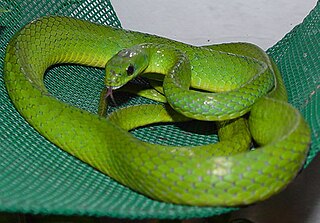
Rat snakes are members – along with kingsnakes, milk snakes, vine snakes and indigo snakes – of the subfamily Colubrinae of the family Colubridae. They are medium to large constrictors and are found throughout much of the Northern Hemisphere. They feed primarily on rodents. Many species make attractive and docile pets and one, the corn snake, is one of the most popular reptile pets in the world. Like all snakes, they can be defensive when approached too closely, handled, or restrained. However, rat snake bites are not dangerous to humans. Like nearly all colubrids, rat snakes pose no threat to humans. Rat snakes were long believed to be completely nonvenomous, but recent studies have shown that some Old World species do possess small amounts of venom, though the amount is negligible relative to humans.

The banded krait is a species of elapids endemic to Asia, from Indian Subcontinent through Southeast Asia to Southern China. With a maximum length exceeding 2 m, it is the longest krait with a distinguishable gold and black pattern. While this species is generally considered timid and docile, resembling other members of the genus, its venom is highly neurotoxic which is potentially lethal to humans. Although toxicity of the banded krait based upon murine LD50 experiments is lower than that of many other kraits, its venom yield is the highest due to its size.

Ptyas korros, commonly known as the Chinese rat snake or Indo-Chinese rat snake, is a species of colubrid snake endemic to Southeast Asia.

Ptyas mucosa, commonly known as the Oriental rat snake, or Indian rat snake, is a common non-venomous species of colubrid snake found in parts of South and Southeast Asia. Dhamans are large snakes. Typical mature total length is around 1.5 to 1.95 m though some exceed 2 m. The record length for this species was 3.7 m, second only to their cousin Ptyas carinata among living colubrid snakes. Despite their large size, oriental ratsnakes are usually quite slender with even a specimen of 2 m commonly measuring 4 to 6 cm only around in diameter. Furthermore, the average weight of ratsnakes caught in Java was around 877 to 940 g, though larger males of over 2.3 m may easily weigh over 2.5 kg (5.5 lb). Their color varies from pale browns in dry regions to nearly black in moist forest areas. Rat snakes are diurnal, semi-arboreal, non-venomous, and fast-moving. Rat snakes eat a variety of prey and are frequently found in urban areas where rodents thrive.
Ptyas nigromarginata, commonly known as the green rat snake or black-bordered rat snake, is a species of snake in the family Colubridae. The species is endemic to Asia.

Ptyas is a genus of colubrid snakes. This genus is one of several colubrid genera colloquially called "rat snakes" or "ratsnakes".

The Sakishima green snake is a species of snake in the family Colubridae. The species is endemic to the Yaeyama Islands in the southern Ryukyu Islands of Japan.

Trimeresurus flavomaculatus is a venomous pit viper species endemic to the Philippines. Two subspecies are currently recognized, including the nominate subspecies described here.

The Chinese green snake is a snake of the family Colubridae.
Acutotyphlops banaorum is a species of snake in the family Typhlopidae. The species is endemic to the Philippines.
Malayotyphlops luzonensis, also known as the Luzon blind snake or Luzon worm snake, is a species of snakes in the Typhlopidae family.

Sanguirana luzonensis, also known as the Luzon frog, is a species of true frog, family Ranidae. It is endemic to the island of Luzon, the Philippines. It occurs in swift-flowing, cool mountain streams and rivers in montane rainforest at elevations up to 2,000 m (6,600 ft). It is very common in many habitats, although it is suspected to be declining because of habitat loss and deterioration.
The Philippine mottled eel is an eel in the family Anguillidae. It was described by Shun Watanabe, Jun Aoyama, and Katsumi Tsukamoto in 2009. It is a tropical eel known from the Pinacanauan River system on Luzon Island, in the Philippines. The eels spend most of their lives in freshwater but migrate to the ocean to breed.

Ptyas fusca, commonly known as the white-bellied rat snake or brown rat snake, is a species of colubrid snake. It is found in Indonesia, Brunei, Malaysia, Thailand and Singapore.

Ptyas carinata, commonly known as the keeled rat snake, is a species of colubrid snake. It is found in Indonesia, Myanmar, Malaysia, Thailand, Philippines, Cambodia, India, Vietnam, and Singapore. This little known species is probably the largest extant species in the diverse colubrid family that includes just over half of living snake species. Known adult lengths of snakes of this species in Taiwan measured anywhere from 1.21 to 2.75 m. However, the reportedly maximum size was about 4 m. Males reportedly average slightly larger than females. They are probably opportunistic predators on a variety of prey, such as rodents, though adult lizards are thought to be significant prey in Indonesia.
Lycodon solivagus, also known as the common wolf snake, is a species of colubrid snake found on Luzon Island in the Philippines.
Oligodon ancorus, commonly known as the northern short-headed snake, is a species of colubrid snake found on the islands of Luzon and Mindoro in the Philippines, and the island of Sumatra in Indonesia. However, whether the populations from Sumatra, described as Oligodon rhombifer, belong to this species has been contested.

Dendrelaphis luzonensis, also known as the Luzon bronzeback treesnake, is a species of snake of the family Colubridae.

Calamaria bitorques is a species of snake of the family Colubridae. It is commonly known as the Luzon dwarf snake.
Ptyas dhumnades, Cantor's rat snake, is a species of snake of the family Colubridae.













